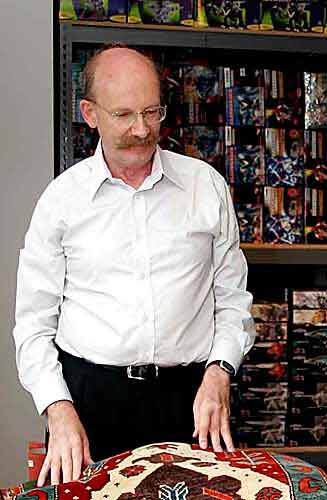
Dr. Jon Thompson
Marika Sardar’s Journal –
Following Dr. Thompson’s Rug Odyssey
Dr. Jon Thompson, curator of the Hajji Baba exhibition, is based in England where he teaches at Oxford and oversees the Mae Beattie archives at the Ashmolean Museum. Although much of the work for the show will be completed over there, last August it was time for Dr. Thompson to come to the States and meet all of the Hajji Baba members whose collections would form the basis of the show.
He had only two weeks to visit members in Washington DC, Wilmington, Philadelphia, New Jersey, Connecticut, Boston, and scattered throughout New York City. He would be joined by me, the assistant curator, and Matt Fried, a photographer. The goal was to see as many rugs as possible, take lots of notes and photographs and then for Jon to return to London and ruminate on his selections for the show.
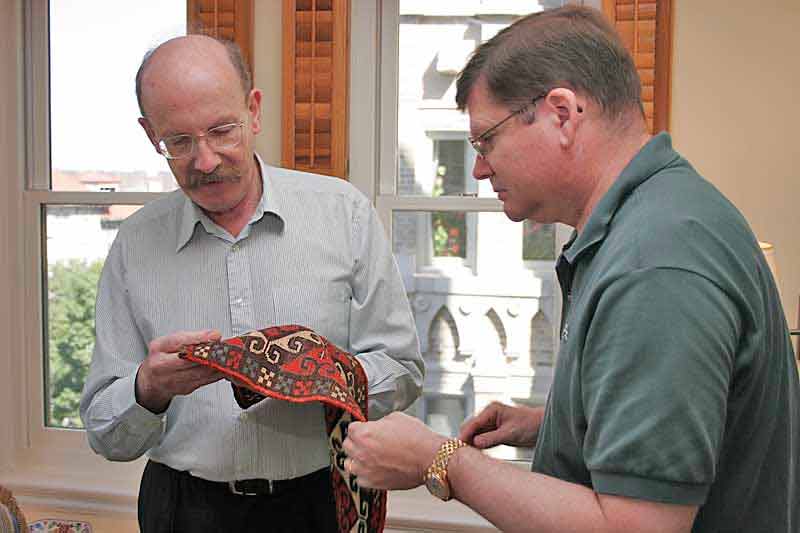
Dr. Jon Thompson and Bruce Baganz examine a Central Asian weaving, Washington, DC
Jon arrived in mid-August and three of us set off immediately for Washington DC, where we were hosted by Bruce Baganz. Bruce’s was a great place to start, with
his collection of objects from all over the Islamic world; we spent an entire morning looking through his rugs,textiles and many other treasures.
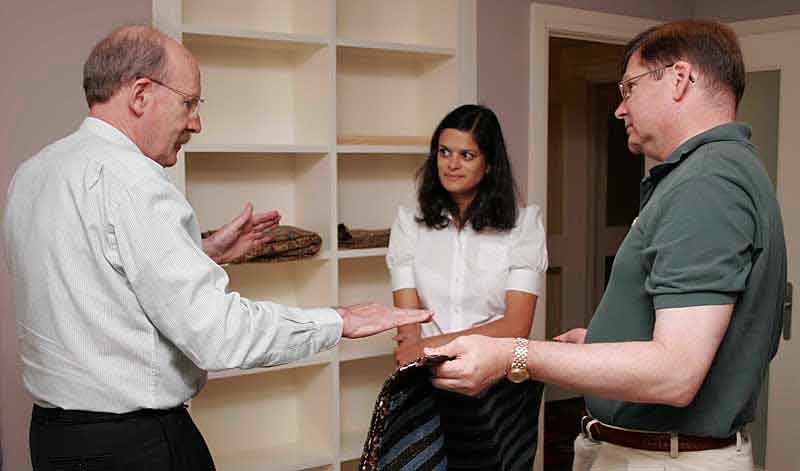
Dr. Thompson practicing… his moves, rather than medicine.
That afternoon we visited Harold Keshishian, who kept pulling out item after item from a magical closet in his study. Jon was particularly excited to find an important, historical Persian rug of which Harold had some rather large fragments. On our second and final day in town we spent many hours combing through the files of the Textile Museum, founded by former Hajji George Hewitt Myers.
Unfortunately the museum’s rugs were inaccessible while its storerooms were being renovated and we had to content ourselves with searching Myers’ extensive collection on the computer. We were graciously hosted there by Mary Hauser, assistant registrar, and Dan Walker, curator of the Club’s 50th anniversary exhibition, now director of the Textile Museum.
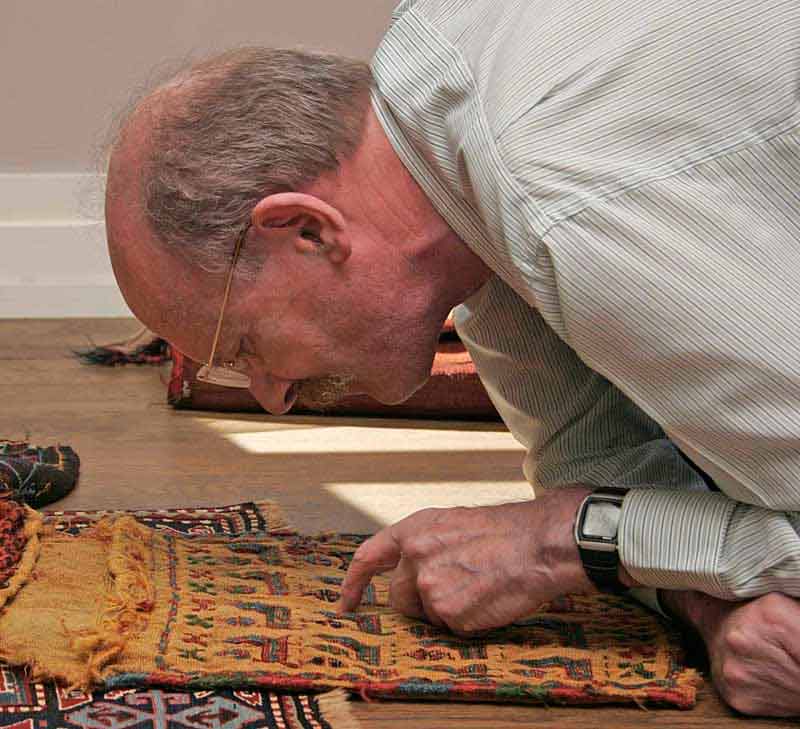
Jon Thompson and a whimsical animal-pattern storage bag at Bruce Baganz’s.
On the afternoon of day three we drove up to Wilmington, arriving in the evening and just in time for a dinner hosted by Bobbie Howrey. She had assembled Caroline and husband Beard, James and Kay Thompson, Tom Schwanke, and Linda Eaton of the Winterthur Museum, who were all waiting for us outside (and enjoying a round of drinks) when we pulled up. We relaxed for a while and Bobbie fed us well, but
immediately after the meal rugs were brought out for Jon’s inspection. A sweet little tapestry-weave rug, belonging to Caroline and which Jon thought was Armenian, was the hit of the night. The next morning he discovered an interesting Turkman bag face that Bobbie had kept draped across a table in her kitchen and well-covered by appliances. We think she may have reconsidered its location after Jon expressed his enthusiasm for it.
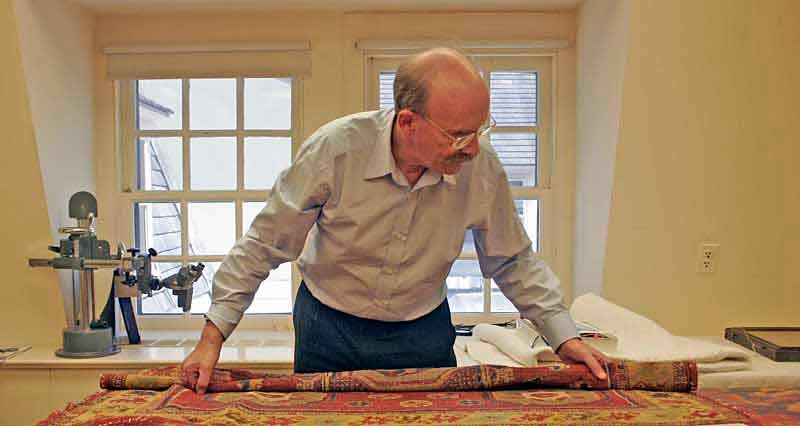
A rug at Winterthur is examined in a study room.
We spent the following day at the Winterthur with Bobbie and Linda, as they took us through Henry du Pont’s estate and the museum’s vast storerooms. It was at Linda’s suggestion that we were there: she had found two boxes of correspondence between du Pont and the Club that seemed to indicate that he had been a member. This meant that his entire collection was available for the
exhibition, initially an exciting prospect. However, during our tour of the museum, it appeared that many of the rugs had been heavily used and repaired. Jon’s verdict on whether they were show-worthy was unclear, but we spent a fun few hours in the storeroom of the museum where rack after rack held valuable examples of classical court carpets.
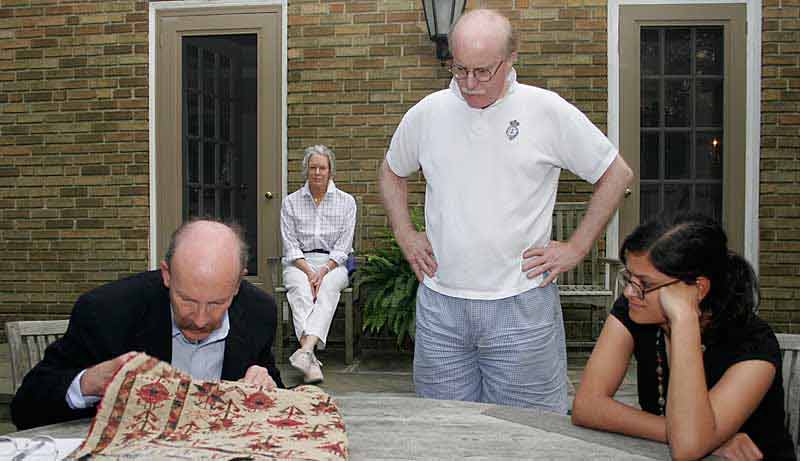
Dr. Jon Thompson closely examines a Saryk asmalyk as Tom Tarantino and his wife, Barbara, look on.
Leaving the museum, we drove onwards to a lively Friday evening in Philadelphia, where we were hosted by Tom Tarantino and Barbara Scott. We received a tour of the beautifully displayed collections in their office and home, and Tom explained his philosophy on collecting items that come in pairs: both he and wife Barbara are twins.
I got to try on some ikat robes (not in pairs); then we all went out for a delicious Japanese meal, at a restaurant where Tom and Barbara seemed to be regulars and good friends with the staff. We retired to the quiet of the Pine Barrens that night, where we stayed with Kurt Munkasci and Nancy Jeffries.
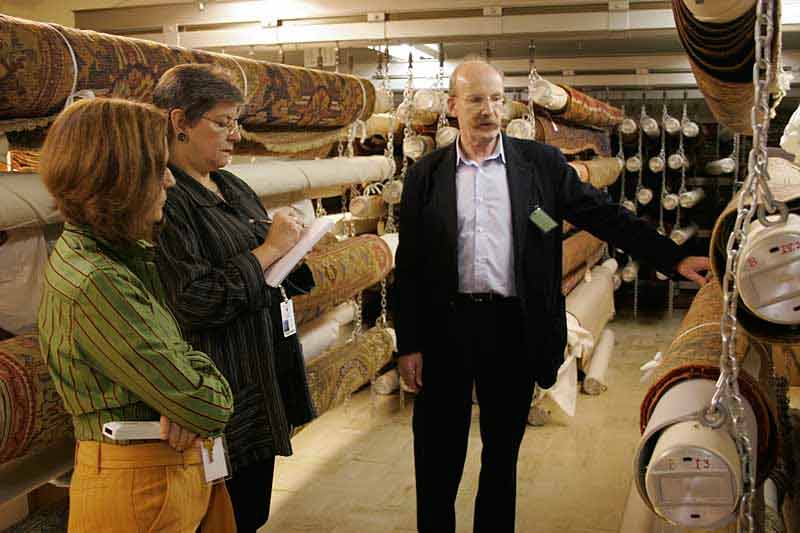
Inspecting the du Pont collection in the storerooms of the Winterthur Museum,
with curator of textiles Linda Eaton.
We arrived at night and could see little of the surrounding landscape, but when we woke up the next morning the forest of pine trees surrounding a field of blueberry bushes was stunning. That day several Hajjis joined us for lunch and Kurt’s tour through the Turkman lands, via his extensive collections (stored in a large closet in the basement: our second magical closet of the trip). Kurt too has an interesting philosophy of collecting, and he showed
us pieces he had collected to demonstrate how motifs change over time, or are copied and transformed in moving from tribe to tribe. Afterwards, Jon took a look at the eclectic group of rugs brought by Ted Mast, David Bosted and wife, and Elizabeth Ettinghausen. We left Kurt’s that afternoon to return to the New York, wrapping up the first leg of our journey.
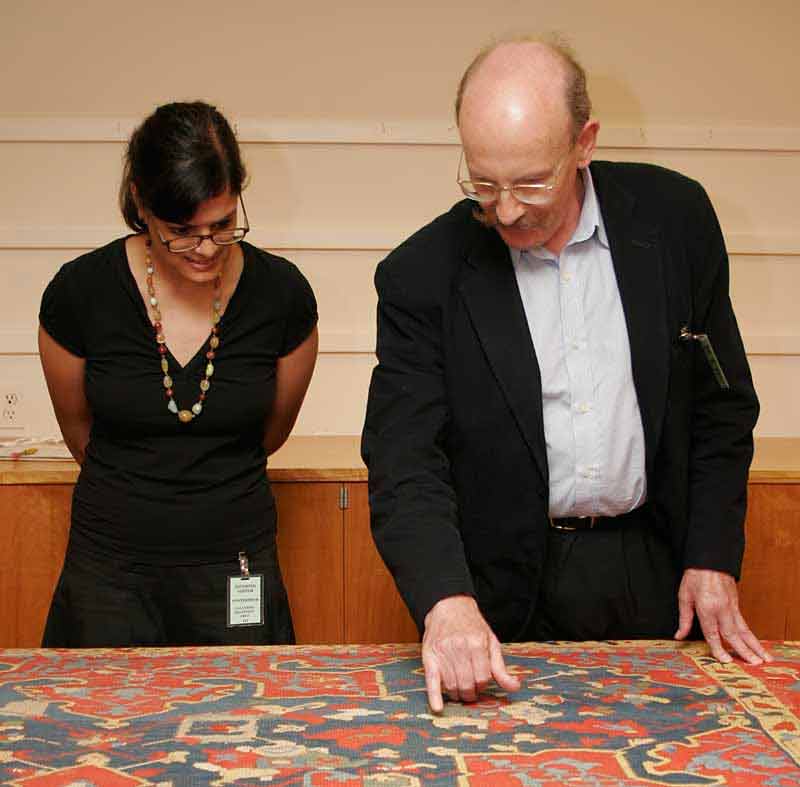
Jon Thompson pointing out repairs in the Winterthur’s Ushak carpet.
Assistant curator Marika Sardar looks on, fascinated.
The next several days were spent taxiing around the city. In lower Manhattan we saw Peter Davies and Marilyn and Marshall Wolf. At the Wolfs’ on Sunday we found some interesting Baluches and kilims that had been dropped off by Harris Feinn and Helen King. Marshall and Marilyn then led us through an abridged tour of two apartments’
worth of stuff: we found a delicately embroidered Algerian cloth, Safavid and Armenian textiles, an Ottoman velvet and more. The tour ended with a viewing of two halves of the same kilim that they managed to find years apart and on different continents.
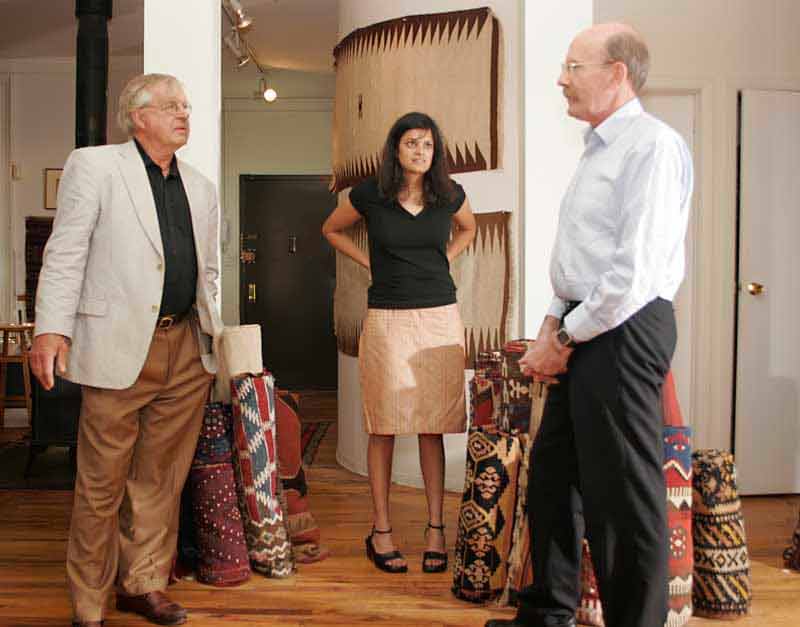
Peter Davies explains a theory to Jon Thompson.
At Peter Davies’ on Monday, although we were shown a wide variety of kilims, Jon’s favorite item was a pair of felt boots Peter had purchased in Turkey. It seemed that Jon would find a way to include these items in the show despite the risk of bugs that any object in felt carries with it.
We also stopped by Mark Shilen’s gallery on Broome Street. Among the highlights there was a seventeenth century Indian eating cloth but again Jon was intrigued the arcane—a pair of Tibetan door rugs that had experienced very hard lives: Matt and I were stumped.
Over the next few days we raced around upper Manhattan. On the east side we visited the homes of Judith Hernstadt, Tripp and Jeannette Miller, Ezra and Reva Mager, Marjorie Lawrence, Layla Diba, and Bruce Westcott (where Jon
was staying). Each, as we found out, collects many types of objects and we enjoyed seeing their rugs and textiles among great examples of antique American furniture, Chinese scholars’ stones, and Indian miniature paintings.
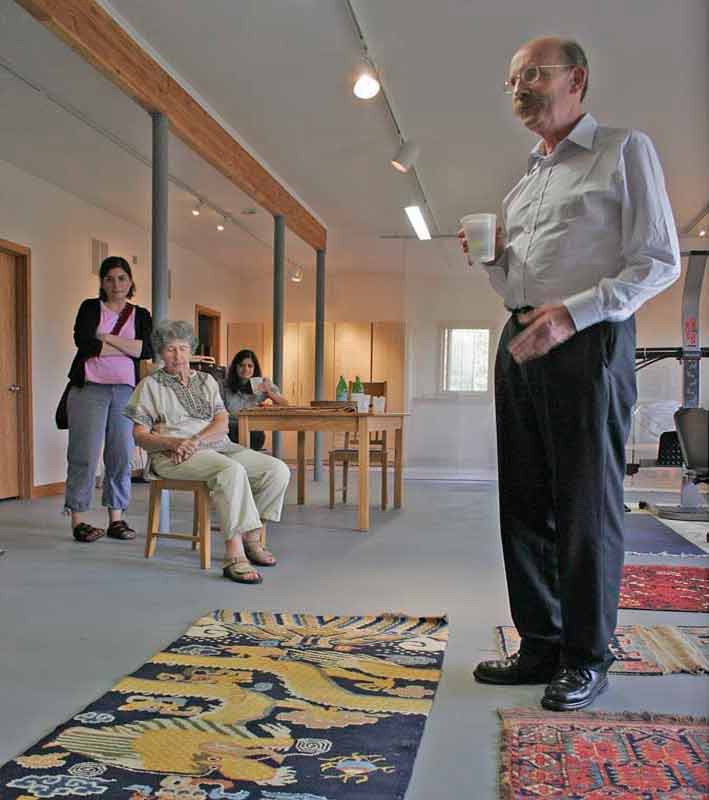
A festival of rugs at Kurt Munkasci’s New Jersey home.
Elizabeth Ettinghausen and friend look on as Jon Thompson waggles his mustache at this offering.
We also went across the park to the west side, where we saw DeWitt Mallary, Bevis Longstreth, Gemma and Lewis Hall, Gail Martin and Arlene Cooper. Mr. Hall’s great-great-grandfather was William Clark, the senator from
Montana who bequeathed many of his great rugs to the Corcoran Musuem; the Halls own what is left from his collection. Together, these visits turned up a great array of tent bands, Baluch rugs, and Ottoman embroideries.
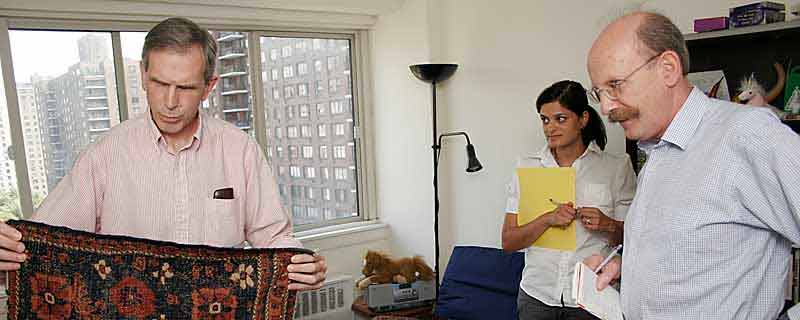
DeWitt Mallary seems puzzled by one of his own rugs as Jon Thompson looks on in bemusement.
AJ Lederman, Joe Doherty, James Morel, Joe Reinis, and Richard White all left a variety of textiles, costumes and rugs at Sotheby’s, where we spent one morning examining
them. Among other finds, one anonymous suitcase held a treasure trove of ikats, robes and hats from Central Asia
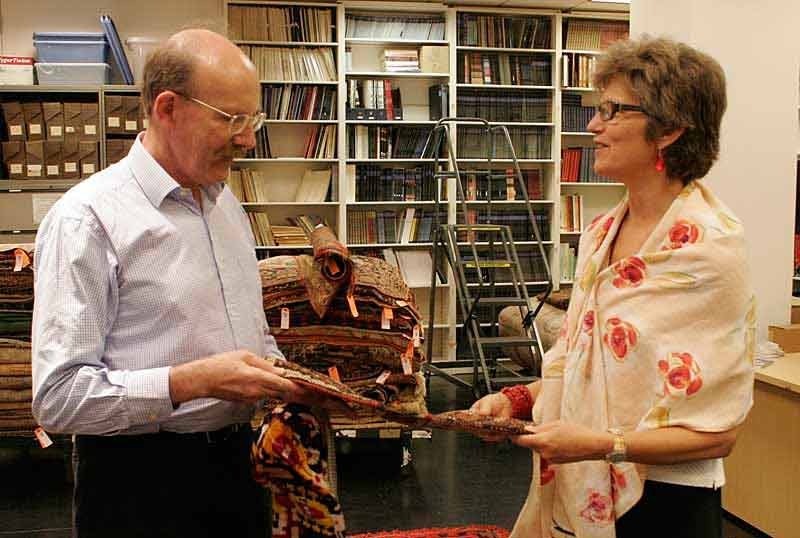
Jon Thompson and Mary Jo Otsea, Vice President of the Oriental and
European Carpets Department, ponder textiles left by members at Sotheby’s.
In midtown we saw Judy Freedman and Marc Feldman. Judy’s love of horses influences her collecting habits as well; she has a fascinating group of animal trappings created in a variety of techniques. Matt offered to photograph any pieces that were selected for the show on
Judy’s horses, who live in Florida. While taking in the great view of the UN we saw Marc’s extensive collection, focusing at Jon’s request on Persian village rugs, but again there were many intriguing closets full of every class of carpet.
During the week there was also a quick trip out to the Brooklyn Museum, where several pieces from Charles Grippi and Virgil Bird had been donated.
These were presented to us by Michael Chagnon, research assistant in the Asian Art department.
We then convened for our final journey on the road, heading north towards Massachusetts and Connecticut. We took a quick tour of Boston; or what was meant to be a quick tour—Brookline’s pretty but unlabeled streets put our navigating skills to the test. While there we stopped by the homes of Dan Baldini and Judy Smith where there were some great suzanis and other interesting finds.
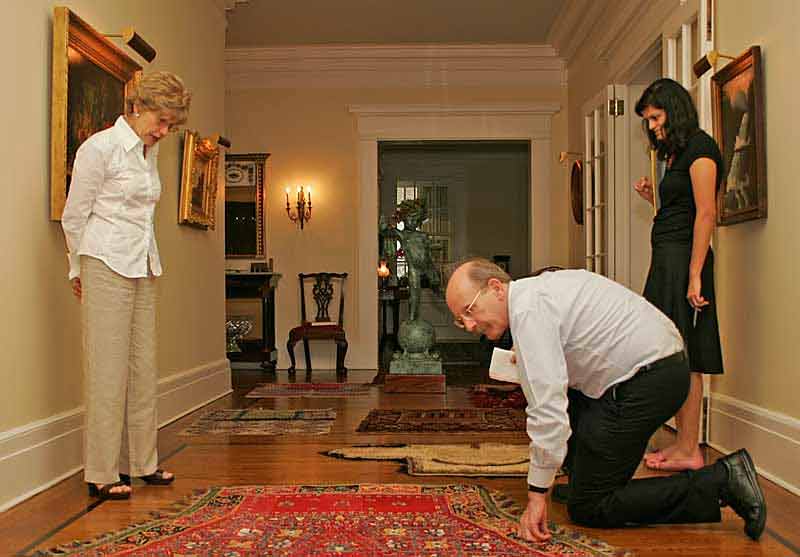
As Judith Brick looks on, Jon Thompson examines an Uzbek embroidered horse cover.
We spent the night in New Haven with Mae and Gene Festa, and the next morning received tours of Mae’s eclectic collection and Gene’s modernist house. Once again closet after closet was emptied for our delectation. Among other
things, we found that Mae’s interest in textiles has led her to also collect items related to their manufacture, including two full mohair skins and a ta’lim, the paper on which the pattern and colors for a carpet were written in code for the weaver.
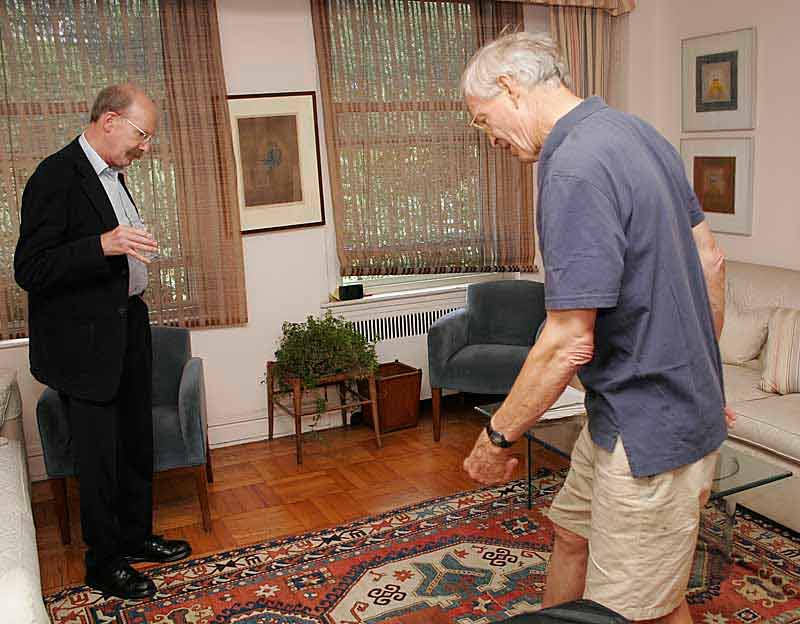
A find in Bevis Longstreth’s living room.
Bill Fern was out of town when we drove through Westport, but we were able to stop by his rambling house with rugs tucked away in every room, on floors, on walls, and you guessed it, in closets.
By nighttime we reached Greenwich, and the home of our hosts Shonu and Vinay Pande. Despite the full weekend ahead of them the Pandes kindly hosted a Friday evening get-together for the Greenwich-area members.
Robert and Helen Hendrikson, Anu Singh, Nick Wright, Madeline Hart and Tyler Jenner all showed up with treasures for Jon to see. Madeline brought some very fine embroideries, and Tyler had some pieces she had picked up when working for the Peace Corps in Afghanistan.
Anu showed us a great range of Indian textiles, exhibited again the next day at the Hajji picnic. Afterwards, we enjoyed visiting Vinay’s underground rug room, bedecked in fabrics and rugs
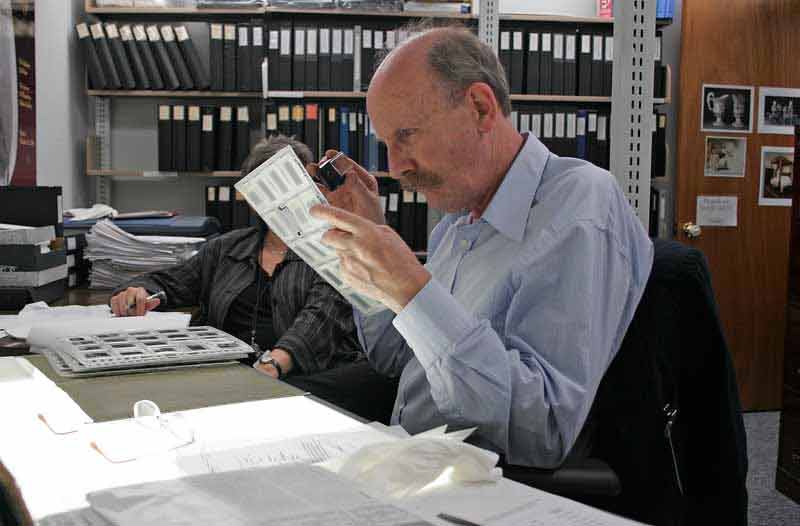
Jon Thompson carefully examines slides of rugs at the Winterthur.
After a few hours’ rest we awoke to Saturday morning and the annual Hajji picnic. Jon’s skills were put to the test one last time, as he helped out Jeff Spur with the show-and-tell. But most importantly, it was a great day to catch up with old
friends we’d made during the previous two weeks, and to meet many new ones—especially over delicious Kashmiri food. Jon, Matt and I would like to thank all of you who opened your homes and shared your collections with us.

 Dr. Jon Thompson
Dr. Jon Thompson Dr. Jon Thompson and Bruce Baganz examine a Central Asian weaving, Washington, DC
Dr. Jon Thompson and Bruce Baganz examine a Central Asian weaving, Washington, DC Dr. Thompson practicing… his moves, rather than medicine.
Dr. Thompson practicing… his moves, rather than medicine. Jon Thompson and a whimsical animal-pattern storage bag at Bruce Baganz’s.
Jon Thompson and a whimsical animal-pattern storage bag at Bruce Baganz’s. A rug at Winterthur is examined in a study room.
A rug at Winterthur is examined in a study room. Dr. Jon Thompson closely examines a Saryk asmalyk as Tom Tarantino and his wife, Barbara, look on.
Dr. Jon Thompson closely examines a Saryk asmalyk as Tom Tarantino and his wife, Barbara, look on. Inspecting the du Pont collection in the storerooms of the Winterthur Museum,
Inspecting the du Pont collection in the storerooms of the Winterthur Museum, Jon Thompson pointing out repairs in the Winterthur’s Ushak carpet.
Jon Thompson pointing out repairs in the Winterthur’s Ushak carpet. Peter Davies explains a theory to Jon Thompson.
Peter Davies explains a theory to Jon Thompson.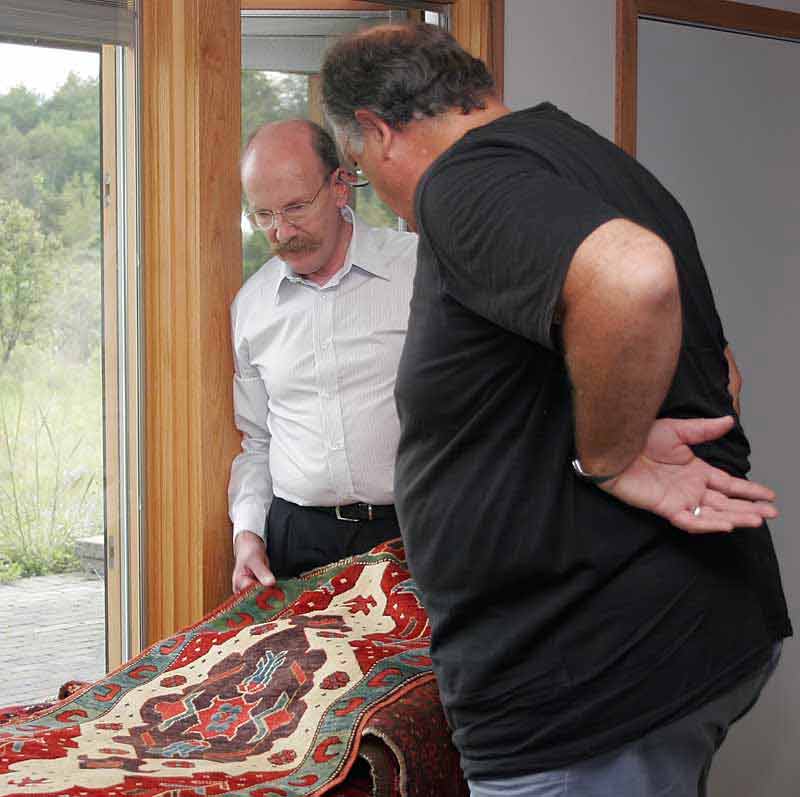
 A festival of rugs at Kurt Munkasci’s New Jersey home.
A festival of rugs at Kurt Munkasci’s New Jersey home. DeWitt Mallary seems puzzled by one of his own rugs as Jon Thompson looks on in bemusement.
DeWitt Mallary seems puzzled by one of his own rugs as Jon Thompson looks on in bemusement. Jon Thompson and Mary Jo Otsea, Vice President of the Oriental and
Jon Thompson and Mary Jo Otsea, Vice President of the Oriental and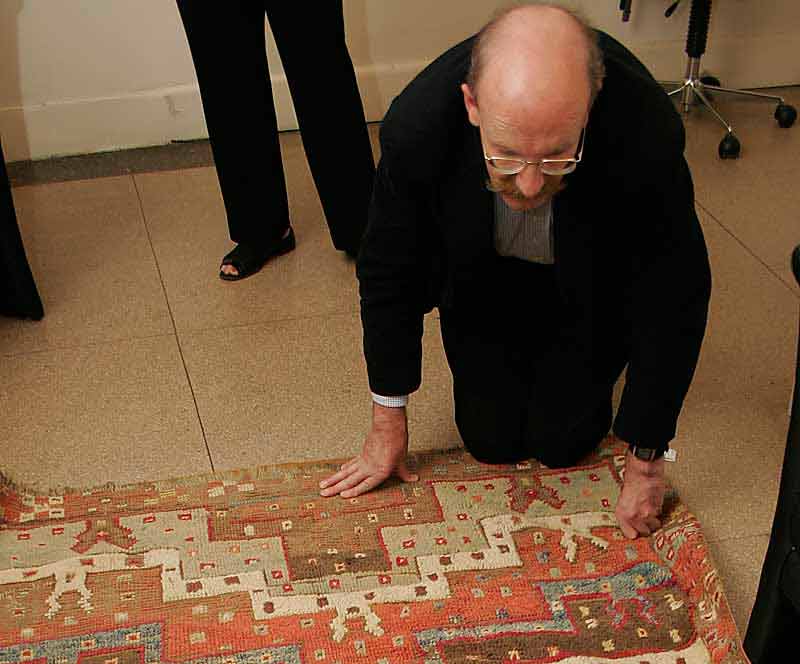
 As Judith Brick looks on, Jon Thompson examines an Uzbek embroidered horse cover.
As Judith Brick looks on, Jon Thompson examines an Uzbek embroidered horse cover. A find in Bevis Longstreth’s living room.
A find in Bevis Longstreth’s living room.
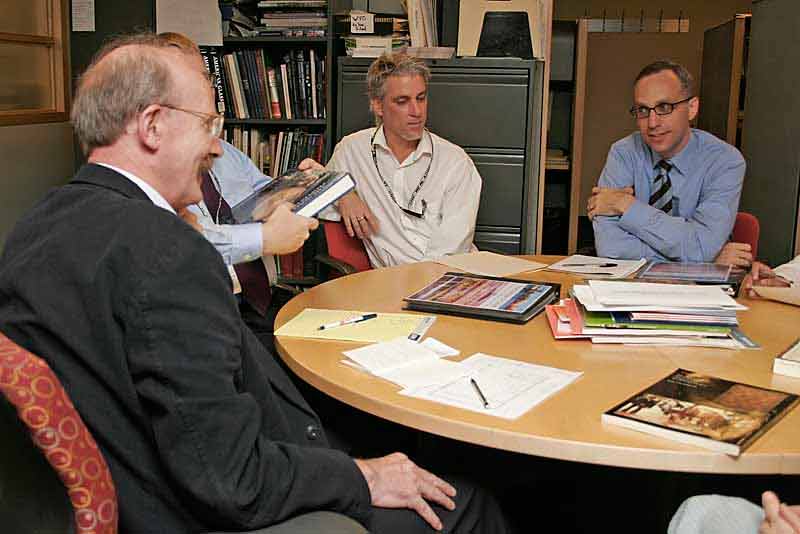
 Jon Thompson carefully examines slides of rugs at the Winterthur.
Jon Thompson carefully examines slides of rugs at the Winterthur.